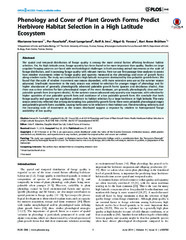Phenology and cover of plant growth forms predict herbivore habitat selection in a high latitude ecosystem
Permanent lenke
https://hdl.handle.net/10037/6652Dato
2014Type
Journal articleTidsskriftartikkel
Peer reviewed
Forfatter
Iversen, Marianne; Fauchald, Per; Langeland, Knut; Ims, Rolf Anker; Yoccoz, Nigel Gilles; Bråthen, Kari AnneSammendrag
The spatial and temporal distribution of forage quality is among the most central factors affecting herbivore habitat
selection. Yet, for high latitude areas, forage quantity has been found to be more important than quality. Studies on large
ungulate foraging patterns are faced with methodological challenges in both assessing animal movements at the scale of
forage distribution, and in assessing forage quality with relevant metrics. Here we use first-passage time analyses to assess
how reindeer movements relate to forage quality and quantity measured as the phenology and cover of growth forms
along reindeer tracks. The study was conducted in a high latitude ecosystem dominated by low-palatable growth forms. We
found that the scale of reindeer movement was season dependent, with more extensive area use as the summer season
advanced. Small-scale movement in the early season was related to selection for younger stages of phenology and for
higher abundances of generally phenologically advanced palatable growth forms (grasses and deciduous shrubs). Also
there was a clear selection for later phenological stages of the most dominant, yet generally phenologically slow and lowpalatable
growth form (evergreen shrubs). As the summer season advanced only quantity was important, with selection for
higher quantities of one palatable growth form and avoidance of a low palatable growth form. We conclude that both
forage quality and quantity are significant predictors to habitat selection by a large herbivore at high latitude. The early
season selectivity reflected that among dominating low palatability growth forms there were palatable phenological stages
and palatable growth forms available, causing herbivores to be selective in their habitat use. The diminishing selectivity and
the increasing scale of movement as the season developed suggest a response by reindeer to homogenized forage
availability of low quality.
Forlag
Public Library of Science (PLoS)Sitering
PLoS ONE (2014), vol. 9(6): e100780.Metadata
Vis full innførselSamlinger
Følgende lisensfil er knyttet til denne innførselen:


 English
English norsk
norsk